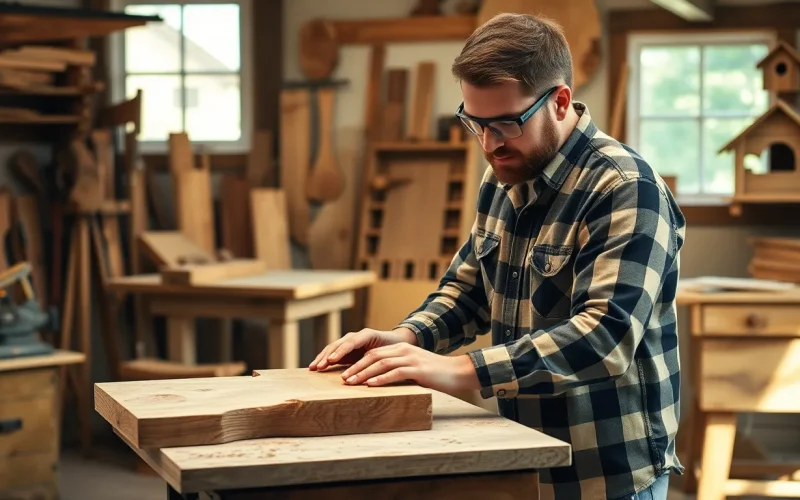Table of Contents
ToggleWoodworking isn’t just a hobby; it’s a journey into creativity that transforms ordinary pieces of wood into extraordinary masterpieces. Whether you’re a seasoned craftsman or a curious beginner, the world of woodwork offers endless inspiration that can make anyone feel like a modern-day Geppetto. Imagine crafting a stunning dining table that becomes the centerpiece of family gatherings or building a quirky birdhouse that turns your backyard into a feathered paradise.
The Essence of Woodwork Inspirations
Woodworking serves as a canvas for creativity, allowing creators to express their artistry through wood. Many find inspiration from nature, using the organic textures and colors of wood to inform their projects. Each piece crafted reflects a unique story, whether it’s a sleek coffee table or a rustic shelving unit. Artists often draw ideas from everyday surroundings, transforming simple materials into stunning masterpieces.
Traditions inspire many woodworkers, with styles ranging from classical to contemporary. Classic designs evoke nostalgia, while modern interpretations push boundaries and redefine aesthetics. Found objects play a significant role in expanding creative horizons, encouraging innovators to repurpose reclaimed materials into fresh designs.
Collaborations between different trades also yield fresh perspectives. Furniture makers frequently partner with artists for custom pieces that blend form and function. This synergy sparks a flow of ideas, resulting in innovative solutions that challenge conventional woodworking.
Technique influences inspiration as well. Simple joinery methods can lead to impressive structural integrity, while intricate carvings add personality to works. Exploring various techniques often enhances a woodworker’s repertoire, encouraging experimentation with new tools and skills.
Colors and finishes significantly impact the final look of a project. Many woodworkers emphasize the natural grain by using clear finishes, while others explore vibrant stains to enhance visual appeal. The choice of color often conveys emotion, adding depth to the piece.
Community interactions further nurture inspiration. Woodworking groups and social media platforms provide venues for sharing ideas and showcasing creations. Engaging with fellow enthusiasts fosters motivation, encouraging individuals to push creative boundaries.
Traditional Woodwork Inspirations

Traditional woodworking offers a wealth of inspiration, rooted in history and craftsmanship. Artisans often draw from ancient techniques and styles to create timeless pieces.
Historical Techniques
Joinery methods like dovetail and mortise-and-tenon showcase the precision of traditional craftsmanship. These techniques provide strength without needing metal fasteners. Techniques such as hand planing and carving emphasize the artisan’s skill, enhancing the piece’s beauty. Woods like oak, walnut, and cherry remain popular choices, each having unique properties that influence the final design. The use of tools like chisels and hand saws harks back to generations past, allowing artisans to connect with their craft’s rich heritage. Through learning these methods, modern woodworkers maintain the integrity of historical artistry while adding their own flair.
Iconic Woodworking Styles
Craftsman, Shaker, and Federal styles offer distinct aesthetics that inspire many woodworkers today. The Craftsman style stands out for its simplicity and functionality, often featuring sturdy construction and natural finishes. Shaker design emphasizes minimalism and utility, showcasing clean lines and well-crafted joints. Federal style incorporates elegance with detailed inlays and curved forms, reflecting early American sophistication. Each style tells a story, representing cultural values and artistic trends. By studying these iconic styles, woodworkers can infuse their projects with a sense of history and tradition, creating pieces that resonate with both past and present.
Modern Woodwork Inspirations
Modern woodworking embraces creativity and innovation, allowing artisans to explore new ideas and techniques. Contemporary styles often feature clean lines and functional designs, emphasizing simplicity and utility.
Minimalist Approaches
Minimalist woodwork focuses on clean, uncluttered designs. This style uses smooth surfaces and natural finishes, allowing the beauty of the wood to shine. Artisans often choose lighter woods, enhancing the lightness of their creations. Simple shapes combined with thoughtful joinery, like finger joints or lap joints, ensure structural integrity while maintaining elegance. A minimalist coffee table or shelf can serve as a striking statement piece in a modern home, embodying the philosophy of “less is more.”
Innovative Materials
Innovative materials expand the realm of woodworking, introducing exciting possibilities. Artisans experiment with composite woods, engineered materials, or reclaimed wood, all adding unique characteristics to projects. Bamboo, for instance, offers impressive strength and sustainability. Meanwhile, resin-infused wood creates stunning visual contrasts, appealing to contemporary aesthetics. Mixing metals with wood, such as incorporating steel or glass, results in visually striking pieces that blend warmth and industrial edge. These materials ignite creativity, enabling woodworkers to push boundaries and create one-of-a-kind furniture.
Nature as a Source of Inspiration
Nature offers an endless reservoir of inspiration for woodworkers, manifesting in organic forms and sustainable practices.
Organic Designs
Organic designs celebrate the natural beauty of wood. They draw from shapes found in plants and animals, encouraging artisans to mimic nature’s curves and lines. Inspired by tree branches, flowers, and wildlife, woodworkers craft pieces that feel alive. Unique grain patterns and rich textures bring a sense of authenticity to each project. Examples include flowing tabletops resembling riverbeds or chairs shaped like leaves. As artisans embrace these organic elements, their work showcases the harmony between craftsmanship and the environment.
Environmental Considerations
Environmental considerations shape modern woodworking practices. Artisans increasingly prioritize sustainability by sourcing reclaimed wood and certified lumber. Reclaimed wood reduces waste while imbuing projects with history and character. Using sustainably harvested materials minimizes ecological impact. Artisans often select species that balance durability with a low carbon footprint. Innovating with eco-friendly finishes further enhances sustainable practices, ensuring that creations remain safe for both users and the planet. By focusing on these considerations, woodworkers not only create beautiful pieces but also honor their commitment to the environment.
Personalization in Woodworking
Personalization in woodworking enhances the uniqueness of each piece, making it resonate with its creator or owner. Custom projects allow artisans to tailor designs to specific needs, showcasing individual styles and preferences.
Custom Projects
Custom projects offer woodworkers a chance to bring personal visions to life. Every artisan can create items that reflect a client’s taste, from bespoke furniture to decorative accents. Unique features set these projects apart, like personalized engravings or distinct wood selections. Designers often consult with clients throughout the process, ensuring the result aligns perfectly with their expectations. Each custom creation becomes a cherished possession, embodying memories and sentiments unique to the owner.
Client Collaborations
Client collaborations foster a sense of partnership in woodworking. Working closely with clients enables artisans to understand their desires and expectations in detail. Together, they can brainstorm innovative ideas, merging the artisan’s skills with the client’s vision. Feedback plays a crucial role, guiding adjustments during the creation process. Successful client projects often result in personalized designs that complement the client’s space while highlighting the craftsmanship involved. Each collaboration not only enhances satisfaction but also builds lasting relationships between artisans and their clients.
Woodworking is more than just a craft; it’s a journey of creativity and self-expression. Each project reflects the artisan’s unique vision and the stories behind the materials they choose. The blend of traditional techniques and modern innovations opens up endless possibilities for inspiration.
As artisans continue to explore the beauty of wood, they not only create functional pieces but also celebrate the connection between nature and craftsmanship. Personalization adds another layer of meaning, transforming ordinary items into cherished heirlooms.
With a supportive community and a wealth of resources available, woodworkers can embrace their creativity and push the boundaries of their craft. The world of woodworking invites everyone to discover their own inspirations and create something truly remarkable.





